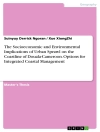This book covers the basic and sustainable approach of nanofiltration membrane techniques along with their fabrication, characterization, separation mechanisms, and broad applications in the field of wastewater treatment. It provides a wide knowledge of nanofiltration technique to water purification audience concerning the recent development with various illustrations, methods and results for graduate students, scientists, academicians, researchers, and industrialists. Readers from wastewater and water purification will have a quick reference by exploring the research literature on the subject field with commercial value-added research applications of nanofiltration membrane.
Зміст
1. Introduction and basic principle of Nanofiltration membrane Process.- 2. Synthesis and characterization of nanofiltration membrane.- 3. Pretreatments before the nanofiltration technique.- 4. Graphene oxide based nanofiltration membrane for wastewater treatment.- 5. Nano-filtration application in the textile industry for wastewater treatment.- 6. Dye removal from industrial water using nanofiltration membrane.- 7. Volatile organic compounds removal by nanofiltration from groundwater.- 8. Desalination through nanofiltration technique .- 9. Modified nanofiltration membrane for wastewater treatment.- 10. Performance of Ceramic Nanofiltration Membranes in Water Purification.- 11. Fouling Mechanisms in Nanofiltration Membranes.- 12. Nanofiltration Technology Applied for Peat and Wetland Saline Water.- 13. Removal of Pollutants from Wastewater through Nanofiltration: A review.
Про автора
Akil Ahmad currently working at Prince Sattam bin Abdulaziz University in Al-Kharj, Saudi Arabia as Assistant Professor in Chemistry and having the experience of seven years as Research Fellow, Teaching Fellow, Postdoc and Visiting Researcher from Universiti Teknologi Malaysia, Universiti Sains Malaysia, University of Kwa Zulu-Natal, South Africa and Universiti Kebangsaan Malaysia, Malaysia. He has completed Ph.D. in Analytical Chemistry (2011) with the topic “Modification of resin for their use in the separation, preconcentration and determination of metal ions” from Aligarh Muslim University (AMU), India. His research interest in the areas of environmental pollutants and their safe removal, synthesis of nanoparticles and Nano-sorbents (GO, CNT), photo-degradation and antimicrobial effects, water and wastewater treatment and adsorption and ion-exchange. He has published more than 100 research articles and chapters in the journals and publishers of international repute such as Scientific reports, Talanta, Chemical Engineering Journal, Journal of Industrial and Engineering Chemistry, Journal of Molecular Liquids etc. He has also edited ten books of Springer, IOP publisher, Bentham and Elsevier. H-index and citation in Scopus are 25 and 2480 and in Google scholar, H-index and citation are 28 and 3189. He is guest editor of many reputed journal namely Adsorption Science and Technology-Hindawi, Polymers MDPI, Forests MDPI, Frontiers in Environmental Chemistry and Journal of Chemistry, Hindawi.
Mohammed B. Alshammari currently working at Prince Sattam bin Abdulaziz University in Al-Kharj, Saudi Arabia as Associate Professor in Organic Chemistry. He received his B.Sc. and M. Sc. degrees in Chemistry from King Saud University, Riyadh, KSA in 2007 under supervision of Professor Abdullah Almajed and Professor Hassan Alhazmi. He worked in Chemistry department in KSU for 9 years as researcher. He received his Ph.D. degree from Cardiff University, UK, in 2013 under supervision of Professor Keith Smith. His research focused in using of organometallic intermediates in organic synthesis. He has published more than 60 International peer-reviewed journal publications and 20 conference proceedings in the area of Organic Chemistry and Chemistry. Supervised 2 M.Sc. students. PI of 3 grants from the University, and 1 grant from the SABIC in collaboration with PSAU. His research interest in the areas of organic synthesis of organic compounds, wastewater treatment and polymers by different methodology such as lithiation reaction, Matteson homologation and others. In addition, He published number of papers about the biological activity for synthesized compounds and pollutants removal from wastewater using different analytical techniques.












